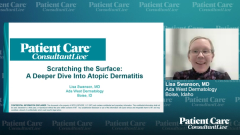
Streamlining Atopic Dermatitis (AD) Diagnosis and Treatment in Primary Care
A panelist discusses how primary care practitioners can implement efficient diagnostic protocols and treatment pathways to better manage atopic dermatitis patients within the constraints of busy clinical settings.
Streamlining Atopic Dermatitis (AD) Diagnosis and Treatment in Primary Care
Diagnostic Approach
- Diagnosis primarily clinical based on characteristic morphology and distribution of lesions
- Key diagnostic features: pruritus, typical morphology (erythema, papules, vesicles), chronic/relapsing course
- UK Working Party criteria useful in primary care: history of flexural involvement, onset before age 2, history of dry skin, personal/family history of atopy
Assessment Tools
- EASI (Eczema Area and Severity Index): objective measurement of extent and severity
- POEM (Patient-Oriented Eczema Measure): validated patient-reported outcome measure
- DLQI/CDLQI: quality of life assessment tools for adults and children
Treatment Algorithm
- Mild Disease: Regular emollients plus low-potency TCS for flares
- Moderate Disease: Regular emollients, moderate-potency TCS, consider TCIs for sensitive areas
- Severe Disease: Intensive topical therapy, consider short-term phototherapy or referral for systemic therapy
Practical Management Tips
- Emollient Strategy: Apply liberally (500g-1kg weekly), select patient-preferred formulations, prescribe sufficient quantities
- TCS Application: Fingertip unit guidance, apply once daily until resolution plus 48 hours
- Infection Management: Recognize signs of secondary infection, targeted antimicrobial therapy when indicated
Referral Criteria
- Diagnostic uncertainty
- Inadequate response to optimized topical therapy
- Severe/widespread disease
- Significant impact on quality of life
- Suspected contact dermatitis requiring patch testing
Primary Care Optimization
- Structured follow-up appointments (2-4 weeks after initial presentation)
- Standardized educational materials for patients/caregivers
- Electronic templates for consistent documentation and treatment planning
- Clear care pathways between primary care and dermatology
Prevention Strategies
- Proactive maintenance therapy on previously affected sites
- Environmental modifications: dust mite reduction, appropriate clothing choices
- Avoidance of identified triggers
- Regular skin care routine even during remission phases
Emerging Considerations
- Point-of-care testing for specific IgE when relevant
- Telemedicine options for follow-up and monitoring
- Integrated care models with nurse practitioners and pharmacists
Newsletter
Enhance your clinical practice with the Patient Care newsletter, offering the latest evidence-based guidelines, diagnostic insights, and treatment strategies for primary care physicians.
















































































































































































































































































